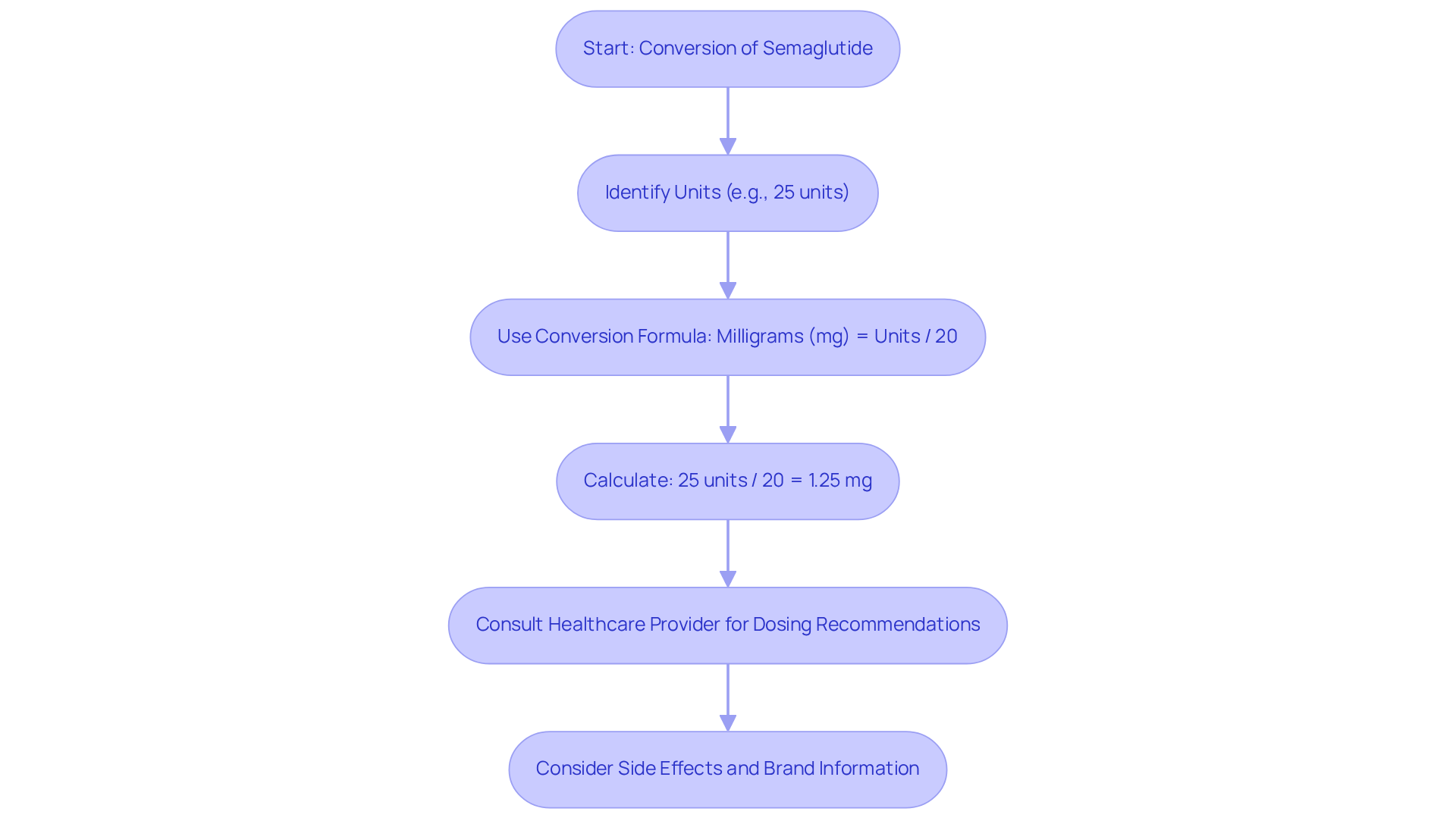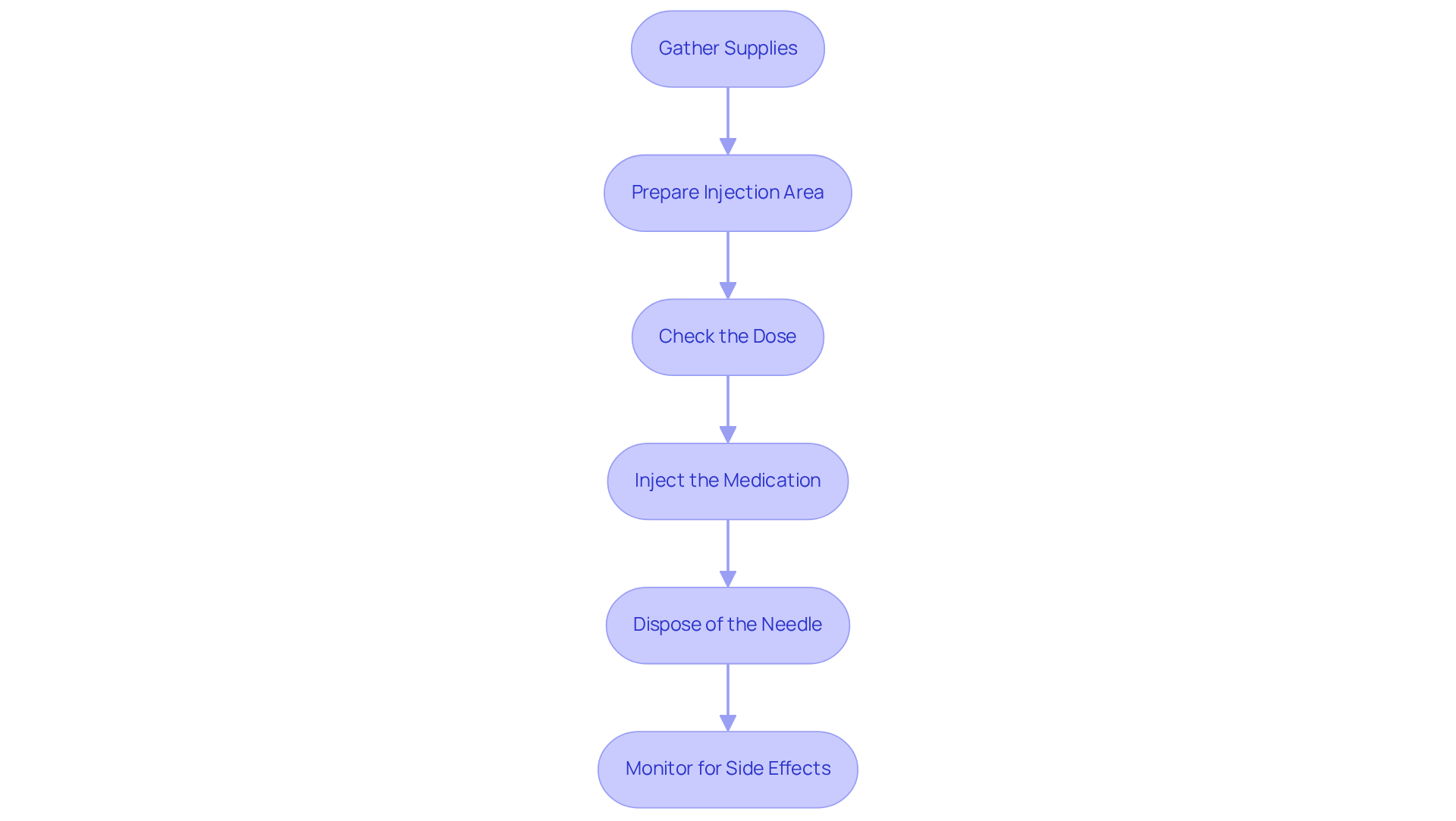Overview
This article gently addresses the conversion of 25 units of semaglutide to milligrams, clarifying that it equates to 1.25 mg based on a standard conversion formula (units divided by 20). Understanding the importance of accurate dosing is crucial for effective treatment, and we want to emphasize that incorrect dosing could lead to ineffective results or unwanted side effects.
We know that navigating medication can feel overwhelming, but we’re here for you. By ensuring you have the right information, we can work together to achieve your health goals. Remember, accurate administration is key to your success, and we’re committed to supporting you every step of the way.
Together, we can make this journey a positive one. If you have any questions or concerns about your dosing, please reach out—your well-being is our priority.
Introduction
Navigating the complexities of medication dosing can feel overwhelming, particularly with treatments like semaglutide, which plays a crucial role in managing type 2 diabetes and supporting weight loss. This guide is designed to simplify the conversion of 25 units of semaglutide to milligrams, offering essential insights into proper dosing and administration.
How can you ensure that you receive the right amount of this important medication while avoiding common pitfalls? In this article, we will explore the conversion process, highlight its significance, and provide practical tips for safe administration, empowering you to take charge of your health journey. Together, we can achieve your goals.
Understand Semaglutide: Basics and Importance
Semaglutide is a glucagon-like peptide-1 (GLP-1) receptor agonist that plays a crucial role in managing type 2 diabetes and supporting weight loss. By boosting insulin release, decreasing hunger, and delaying gastric emptying, this medication effectively helps in managing blood sugar levels and encourages substantial weight loss. Have you ever felt overwhelmed in your weight loss journey? You’re not alone. Recent studies indicate that approximately 75% of patients continue with the treatment after 12 months, showcasing its effectiveness and acceptance in clinical practice.
Understanding the concentration of this medication is essential, especially when considering that 25 units of semaglutide is how many mg, as it is usually quantified in doses for injection, which can lead to confusion when converting to milligrams (mg). For instance, a common starting dose of 0.25 mg raises the question of 25 units of semaglutide is how many mg. This knowledge is vital for anyone using this medication, as incorrect dosing can result in ineffective treatment or unwanted effects. Potential side effects may include stomach discomfort, nausea, and reduced vitamin B12 levels with long-term use. Healthcare experts emphasize the importance of accurate dosing to optimize the benefits of the medication, especially in achieving lasting weight loss results.
Furthermore, this medication enhances long-term A1C levels and can be administered with or without insulin. Real-world examples show that patients can lose between 5% to 15% of their initial body weight over several months when adhering to the prescribed regimen. Together, we can achieve your goals, and a clear understanding of the medication dosing is paramount for effective treatment and optimal health outcomes. Remember, we’re here for you on this journey.
Apply the Conversion Formula: Units to Milligrams
Converting semaglutide from units to milligrams can be straightforward with the right formula.
Conversion Formula: Milligrams (mg) = Units / 20.
For example, to determine 25 units of semaglutide is how many mg, simply calculate: 25 units / 20 = 1.25 mg. This formula is based on the standard concentration of semaglutide, which is typically 20 units per milligram. It’s important to check the concentration of your specific formulation, as variations can occur.
If you’re managing your body mass with Wegovy®, the recommended standard maintenance dosage is 2.4 mg, administered weekly. Wegovy® is an FDA-approved GLP-1 injection that mimics the gut hormone GLP-1, helping you achieve significant weight loss by reducing hunger and improving metabolic health. Recent studies underscore the importance of precise dosing to optimize treatment results, in line with current health organization recommendations.
Additionally, this medication is available under three distinct brand names: Ozempic®, Wegovy®, and Rybelsus. It’s essential to consult with your healthcare provider for personalized dosing recommendations, especially considering potential gastrointestinal side effects such as nausea, vomiting, and diarrhea.
At Minimal, we understand that embarking on a weight reduction journey can be challenging. That’s why we offer a comprehensive approach that combines medication prescriptions with tailored fitness and nutrition advice, supporting you every step of the way on your path to improved wellness. Remember, we’re here for you, and together, we can achieve your goals.
Measure and Administer Semaglutide Correctly
To ensure the accurate and safe administration of semaglutide, please follow these essential steps:
- Gather Supplies: Begin by preparing your semaglutide pen, alcohol wipes, and a sharps container for the safe disposal of used needles.
- Prepare the Injection Area: Choose a comfortable location on your abdomen, thigh, or upper arm. Gently clean the area with an alcohol wipe and allow it to dry completely, ensuring a safe injection. The question to consider is, 25 units of semaglutide is how many mg?
- Check the Dose: Adjust the dose selector on your pen to the appropriate number of units based on your conversion—remember, for example, that 25 units equals 1.25 mg.
- Inject the Medication: Hold the pen at a 90-degree angle to your skin. Insert the needle quickly and press the dose button until the dose counter reads zero, ensuring that the full dose is delivered.
- Dispose of the Needle: Immediately place the needle in a sharps container to prevent any risk of injury.
- Monitor for Side Effects: After your injection, be vigilant for any potential side effects, such as nausea or gastrointestinal discomfort. If you notice any unusual symptoms, please consult your healthcare provider.
Healthcare providers emphasize the significance of correct administration methods to enhance the effectiveness of semaglutide while reducing discomfort. Remember, consistency in your injection routine is key to achieving optimal results. Together, we can navigate this journey towards better health, and we’re here for you every step of the way.
Conclusion
Understanding the conversion of semaglutide units to milligrams is essential for anyone on this journey toward better health, whether for diabetes management or weight loss. We recognize that accurate dosing is crucial, as improper administration can lead to ineffective treatment or even adverse effects. By grasping the conversion formula and following the correct injection procedures, you can maximize the benefits of semaglutide and work towards achieving your health goals effectively.
Key points discussed include:
- The significance of semaglutide as a GLP-1 receptor agonist
- Its mechanism of action in regulating blood sugar levels
- The typical conversion of 25 units to 1.25 mg
It’s also vital to consult healthcare providers for personalized dosing recommendations and to monitor potential side effects, ensuring a safe treatment experience.
Ultimately, your journey towards better health through semaglutide requires a commitment to understanding how to manage dosage accurately. By following the outlined steps and seeking guidance when needed, you can navigate your treatment with confidence. This knowledge not only empowers you but also reinforces the importance of informed decision-making in achieving lasting health outcomes. Remember, together, we can achieve your goals, and we’re here for you every step of the way.
Frequently Asked Questions
What is semaglutide and what role does it play in managing health?
Semaglutide is a glucagon-like peptide-1 (GLP-1) receptor agonist that helps manage type 2 diabetes and supports weight loss by boosting insulin release, decreasing hunger, and delaying gastric emptying.
How effective is semaglutide in weight loss and diabetes management?
Approximately 75% of patients continue treatment after 12 months, indicating its effectiveness and acceptance in clinical practice for managing blood sugar levels and encouraging substantial weight loss.
How is semaglutide typically quantified for dosing?
Semaglutide is usually quantified in doses for injection, which can lead to confusion when converting to milligrams (mg). For example, a common starting dose is 0.25 mg.
What are the potential side effects of semaglutide?
Potential side effects may include stomach discomfort, nausea, and reduced vitamin B12 levels with long-term use.
Why is accurate dosing of semaglutide important?
Accurate dosing is crucial to optimize the benefits of the medication, avoid ineffective treatment, and minimize unwanted effects, especially for achieving lasting weight loss results.
How does semaglutide affect long-term A1C levels?
Semaglutide enhances long-term A1C levels and can be administered with or without insulin.
What kind of weight loss can patients expect when using semaglutide?
Patients can lose between 5% to 15% of their initial body weight over several months when adhering to the prescribed regimen.




















